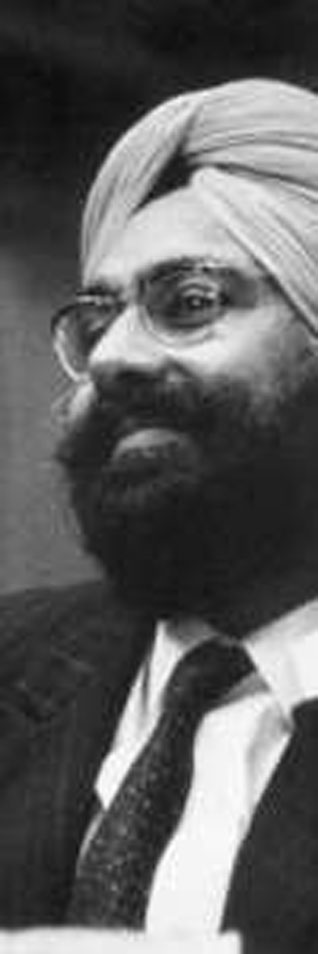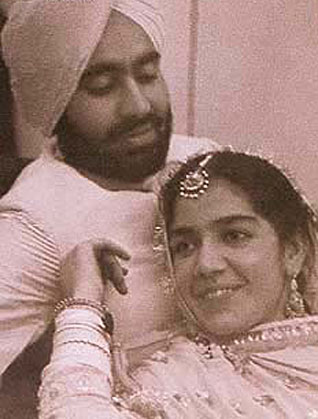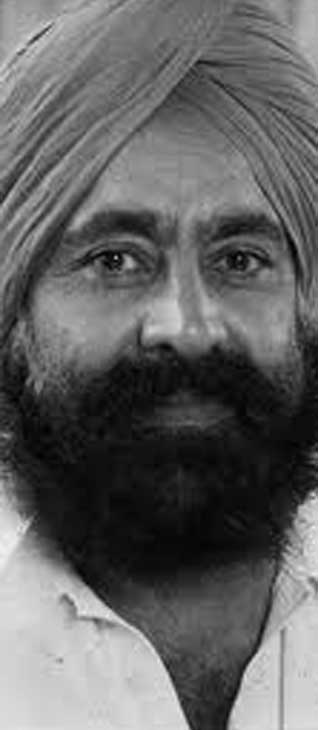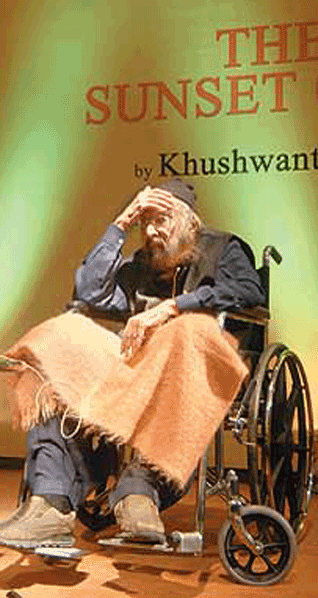People
Grand Old Man of Letters:
Khushwant Singh 1915-2014
SHEELA REDDY
KHUSHWANT SINGH
February 2, 1915 - March 20, 2014
"He passed away peacefully at his residence in Sujan Singh Park, New Delhi ..." He was 99.
He lived an extraordinary life, helping shape the middle-class Indian intellect for the full span of India's very existence, all the way since its traumatic birth in 1947, to this very day, as the country continues to remain embroiled in petty, selfish and fiissiparous rivalries.
Perhaps the single most representative moment of his life and career would be in 1984, when he returned one of the country's highest ciivilian awards in protest at the Indian government's criminality in sending troops into the Golden Temple in order to bolster Indira Gandhi's dictatorial hold on power.
Sardar Harinder Singh ("1469") sends us the following note from New Delhi:
"The great man donated his eyes. Dr IPS Kalra performed ardaas. Arpana Caur and I had the honour of tying his favourite saffron dastaar on him. His body was cremated in the presence of his son Rahul Singh, daughter Mala Singh Dayal, grand-daughter Naina and innumerable friends and well-wishers. At his home, Prime Minister Manmohan Singh, First Lady Gursharan Kaur, Ajit Caur, Sonia Gandhi, Sorabjee, Bishen Singh Bedi, Bubble Charanjit Singh, and many others were in attendance."
The following piece, first published on sikhchic.com in October 2011 upon his retirement from active journalism, is republished today as a tribute to him.
Last week, millions of newspaper readers around the world woke up to find their weekly fix missing.
The ‘Sardar in the Lightbulb’, loved and loathed in over 17 Indian languages, had hung up his pen without saying goodbye. After more than 70 uninterrupted years of ceaselessly needling readers, Khushwant Singh suddenly decided he’d had enough.
“I’m 97,” (he isn’t, he’s 96) “I may die any day now,” is all he’ll say about his self-imposed exile into silence.
“I’ll miss the money,” he says when I prod him, adding as an afterthought: “And the people fawning over me to write about them in my columns.” Fat chance, considering that the same evening, he was entertaining two editors, one of whom was trying to trawl yet another book out of his old columns and the other had brought along his latest novel for him to review.
“You want me to praise it?” he asked, almost innocently. “Yes!” was the fervent response. Perhaps he did not know Khushwant’s column-writing days are over.
It has been a long journey, starting with his days as a briefless lawyer in Lahore, Punjab in 1940, when the bored and just-married Khushwant began contributing book reviews to the Tribune. But even then, the irrepressible writer of middles and short stories knew how to prick inflated egos and raise controversies. When, for instance, he was snubbed by a minister in the Punjab legislative council, Sir Manohar Lal, Khushwant wreaked his revenge by writing a three-part series on him for the Tribune. He changed the minister’s name to Sir Mohan Lal, a ridiculously stiff British loyalist with his very Indian wife, but the portrait was life-like enough to be recognised. The subject was offended, but the readers loved it.
For Khushwant, that first portrait of a pompous minister set the tone for his journalistic writing. He had discovered how to use humour as a lethal weapon: “If you get angry, it doesn’t serve the purpose. But make somebody into a laughing stock and you kill him.” It served him well whenever he turned to journalism, especially when writing for foreign publications like the New York Times, Harper’s and the Toronto-based Globe and Mail.
Khushwant’s gift for needling people and raising controversies became apparent long before he joined the Illustrated Weekly of India.
In the mid-’50s for example, when he quit his UNESCO job to join as editor of Yojana. It was a journal that no journalist would ever take seriously, its only aim being to publicise the five-year plans the government had started. But his bosses had not reckoned with their new editor’s journalistic zeal: he prepared dummies, rewrote deadly dull government speeches, wrote an editor’s page calculated to perk up readership, and gave it a champagne launch. He even managed to rake up a controversy - by splashing over several pages of the journal a speech given by S.K. Dey, advocating that Hindus eat beef. Dey, a pioneer of the community development programme, believed passionately that it would solve the problem of stray, starved cows on the roads. It took Khushwant to highlight it - landing them both into trouble.
It was either Khushwant’s gift for making a splash even in the unlikeliest of journals or the fact that he was sought after by several foreign journals, including the NYT, as a contributor. But within two years of taking over as editor of Yojana, the owners of the Times of India group offered him the job of editor of their picture magazine, the Illustrated Weekly. The then Irish editor, C.R. Mandy, was retiring, and Khushwant seemed the right man to replace him.
It wasn’t exactly a plum job.
In fact, his friends and family thought he was better off at Yojana. “It’s just a picture magazine with photographs of newly-married couples and strip cartoons, not to be taken seriously,” a friend advised him. But Khushwant had no such doubts: “I would have jumped at it if I hadn’t just been offered the Rockefeller grant for researching my books on Sikh history.”
Journalism would have to wait.
The Jains were more than ready to wait for the four years it took him to complete his History of the Sikhs, refusing to appoint another editor to take Mandy’s place until Khushwant returned from the U.S.
It was well worth it, as V.S. Naipaul perceptively noted a few years ago: “Khushwant Singh changed Indian journalism when he became editor of the Illustrated Weekly in 1969. Until then in India the daily newspapers reported speeches, and the picture magazines did art and dance. Khushwant began to give the country a picture of itself. He did this in a serious but not solemn way. His vision was many-sided and rounded. He always had a feeling for what was glamorous, photogenic and exciting, and his readers loved him for it, as they still do.”
Not least of the Weekly’s attractions was Khushwant’s Editor’s Page. For the first time in Indian journalism, he insisted on taking over one page for himself. But instead of building himself up by pontificating and printing his own mugshot, he started writing “about anything that came to my mind, including why some monkeys have red bottoms, which shocked people”.
But there was a reason why the Editor’s Page soon became the most widely read page - “his appetising way of writing,” as Naipaul describes it. “It looks easy to copy, but it isn’t, because the writing comes from a very special relishing of people and experience and a great generosity of spirit. Khushwant has always been a selfless encourager of Indian talent. It’s his own brand of patriotism.”
The “appetising” writing was no accident: Khushwant honed the art during the years he spent in the U.S., lecturing in American universities and colleges like Princeton, Hawaii and Swarthmore. Faced with classrooms of students who knew little about contemporary India, he discovered some tricks to keep his students awake through his lectures. “It became a challenge to keep them awake. I made the lectures very elementary, and filled them with as many anecdotes as I could unearth.”
It was a skill he took with him as he stepped into journalism: “Some gossip, some titillation, some tearing up of reputations, some amusement - that is the best I can offer.” But the combination of serious-but-not-solemn was something that readers in India had not experienced before. They were hooked, right from the start.
And then they began to seek him out. Bombay’s starlets, adventurers, godmen, writers, lawyers, ministers, politicians, tycoons, cranks approached him in a myriad ingenious ways. Once, for instance, when he wrote in his column about how a pickpocket had made off with his Cross pen, Soli Sorabjee’s wife sent him a new one, along with an invitation to dinner. Nani Palkhivala invited him to preside over his annual budget speech delivered in a stadium; Kamini Kaushal claimed old Lahore ties (Khushwant went to college with her brother); Raj Kapoor invited him for a private film screening; I.S. Johar bribed his way into Khushwant’s home by bringing juicy gossip; Persis Khambatta came to plead not to publish her pictures that had appeared in Playboy, disarming him by falling at his feet. All grist to his writing mill, his unerring eye for the human foible in each of them making his Editor’s Page ever more popular.
Nine years later, when the Jains sacked him, the circulation of the Weekly had soared from 60,000 to 4.1 lakh. The only thing he decided to take away with him, besides his umbrella, was his column. He didn’t know it then, but it was the golden goose. In the years to come, it would reach several hundred thousand more readers than the Weekly could ever claim, in every Indian language, making him the most widely read columnist anywhere in the world.
In 1978, however, syndicated columns were still decades away. The Editor’s Page travelled with Khushwant to his next paper, the Congress-owned National Herald. Any other editor in his shoes, asked to edit a daily which came out sporadically, in between police raids, would have probably dropped that column. Dropped that irreverent, housecoat-and-slippers tone, at any rate. But Khushwant stuck to his weekly deadline, producing the same long piece, short piece and joke at the end for as long as he lasted at the Herald.
At his next job as editor, in the Hindustan Times, his column was even more incongruous amidst all the sermons on the editorial page. But having little else to do as editor of a daily, Khushwant stuck on stubbornly with it, having rechristened it as With Malice Towards One and All but with the same sardar-in-a-lightbulb logo that cartoonist Mario Miranda had originally designed for him. To the surprise of those who had dismissed Khushwant as a lightweight who knew nothing of political journalism, the circulation of the daily went up significantly on Saturdays, when Khushwant’s column appeared on the editorial page.
Rival papers began to eye the column which, for reasons that no journalist or editor could fathom, seemed to have a life of its own, packaged into bestselling books by enterprising publishers long after they had been published by the daily.
Outlook editor Vinod Mehta recalls how he first spotted the syndicate potential of the Malice column. In 1981, about to launch a weekly newspaper, The Sunday Observer, Mehta approached Khushwant for rights to reproduce the column. Khushwant, who had not thought of syndication so far, asked the paper’s owner, K.K. Birla, who readily agreed, perhaps because the Hindustan Times didn’t exist in Bombay at that time.
Readers in Bombay warmed up to the column almost at once. One of the first columns the Observer carried was Khushwant’s obituary of Rajni Patel. Characteristically, Khushwant chose to recount a story about how Patel tried to raise funds for drought relief: by inviting potential funders to his home and serving them Royal Salute whisky, which cost Rs 1,500 a bottle. It sparked off a fierce controversy on the letters pages, with angry readers ticking off Khushwant for “writing ill of the dead”.
Others began to want a piece of the Malice pie. But they had to wait till Khushwant left Hindustan Times - or rather, was asked to go because of his differences with Indira Gandhi. He left the paper, but his column stayed. For Khushwant, the disappointment of not getting an extension as editor in Hindustan Times was more than compensated by the number of newspapers across the country vying for his column. In fact, the pressure to produce a fresh column in every state in India in every major language eventually forced Khushwant to write two weekly columns instead of one.
It couldn’t have been much fun: getting up before dawn every single day, an endless round of deadlines, chasing payments, readers’ letters, keeping track of events, and people dropping in, hoping to be written about. Now that he has given it all up, you’d think he’d rest. But he’s already reaching for his yellow legal pad, scribbling away as if it’s a guilty pleasure. “I can’t stop,” he says a trifle sheepishly, “I don’t know how to sit and do nothing.” The columns are done and over with - but it looks as if another book is on its way.
[Courtesy: Outlook. Edited for sikhchic.com]
First published here on October 22, 2011. Republished on March 20, 2014
Conversation about this article
1: Baldev Singh (Bradford, United Kingdom), October 22, 2011, 12:54 PM.
An icon in the literary world. And a good example of a rebel.
2: Gurjender Singh (Maryland, U.S.A.), October 22, 2011, 5:39 PM.
Besides his weekly columns, I would like to thank Khushwant Singh for his excellent books on Sikh history and gurbani translations into English for the young and for the generations to come. May God bless him with long life and good health.
3: Sangat Singh (Kuala Lumpur, Malaysia), October 24, 2011, 2:05 AM.
I met this vintage Sardar three times. The first time it was in the early 60s when he was in Malaysia researching for his book, "The Sikhs". I was the occasional translator for Punjabi, which was heavily laced with Malay language from the first generation veterans. The second and third meetings were more social when he regaled us with his engaging and sparkling observations. I will share one such: Soon after the attack on the Darbar Sahib in 1984, he found himself in the bad books of the Bhindranwala Taksal, was declared a tankhaiyya and summoned to explain his conduct. With some trepidation, he produced himself to answer the charges if any at their court in Chowk Mehta. The Taksalis welcomed him and read out the first charge: "Khushwant Singh ji, we want you to do something forthwith - stop dyeing your beard.". That was the main charge, and then: "Kee chhako gay?" - "What shall you eat?" Case dismissed and go forth and live a hundred years and beyond!
4: Rosalia (Baltimore, Maryland, U.S.A.), May 05, 2012, 2:51 PM.
What an inspiration for any writer in any country!
5: Upkar Singh (Belgium), March 20, 2014, 6:20 AM.
The Grand Ol' Sardar enthralled, entertained, informed, educated, satirized, laughed with and laughed at, scolded, even shaped the minds of Indians for more than half-a-century. That is, for their entire history since the caesarian birth of the country in 1947. There was no one like him ... and the way things are going in that silly land, there won't be another such for a long, long time. May Waheguru bless him ... may he rest in peace.
6: Prabhjot Kaur (New Delhi, India), March 20, 2014, 6:35 AM.
Indeed, the end of an era. He spoke his mind freely ... and couldn't be bought by either politician or corporation. He thumbed his nose to power and pretense. He will be sorely missed, especially in this day and age when almost every journalist in this country resides in someone else's pocket.
7: Karam Singh (London, United Kingdom), March 20, 2014, 7:46 AM.
There is no doubt about it: despite all his quirks and eccentricities, a giant has left the stage. He served his Sikh community well, with class and courage and a heavy dose of Punjabi joie de vivre. And he held Indians by their collective ear and tried hard, really, really hard, to get them to walk a straighter line. A Sardar who -- despite all his failings, like each one of us -- embodied so much of what we Sikhs are and stand for.
8: Harinder Singh 1469 (New Delhi, India), March 20, 2014, 7:52 AM.
The great man donated his eyes. Dr IPS Kalra performed ardaas. Arpana Caur and I had the honour of tying his favourite saffron dastaar on him. His body was cremated in the presence of his son Rahul Singh, daughter Mala Singh Dayal, grand daughter Naina and innumerable friends and well-wishers. At his home, Prime Minister Manmohan Singh, First Lady Gursharan Kaur, Ajit Caur, Sonia Gandhi, Sorabjee, Bishen Singh Bedi, Bubble Charanjit Singh, and many others were in attendance.
9: Dr Birinder Singh Ahluwalia (Toronto, Ontario, Canada), March 20, 2014, 8:41 AM.
May God bless his noble soul for eternity!
10: Harinder Pal Singh (Punjab), March 20, 2014, 12:54 PM.
May we have more such prolific writers like dear Khushwant ji. Waheguru bless his soul. He will be missed by all of us for a long time to come.
11: Sunny Grewal (Abbotsford, British Columbia, Canada), March 20, 2014, 1:37 PM.
I am not sure why I am so surprised by his passing. I think that Khushwant Singh was one of those figures that you would expect to be around forever. I would like to thank this man for "A Train To Pakistan", one of my favorite novels.
12: Manjeet Shergill (Singapore), March 20, 2014, 8:31 PM.
Rest in Peace!
13: Gurmukh Singh (London, United Kingdom), March 21, 2014, 5:07 AM.
The greatest journalist from the subcontinent -- and a Sikh to boot! -- of our times is no more. I had the privilege of spending some time with him at Kasauli a few years ago. A witty and warm person.
14: Bhupinder Singh Bakshi (Washington, DC, USA), March 24, 2014, 3:55 PM.
A great writer, loved nature, was a witness how New Delhi developed during early 20th century in Lutyen's days. Great contributor for Sikh History. Straight forward, he wrote valiantly. He was a witness to 1947 ('freedom at midnight'). He wrote good jokes.
15: Tejinder Singh Bedi (Gurgaon, India), June 17, 2015, 8:53 PM.
One of the most inspiring personalities in the literary world from India. It was a great feeling every time I could catch him at his residence at Sujan Singh Park. He was extremely affectionate and considerate, contrary to all misgivings about his stern receptions at home. All that he wanted was that people meet him according to his schedule, with prior appointments. A strict disciplinarian and a great believer in tenets of Sikhism, which he practiced religiously without dramatizing these or making these public. A great patriot too. He was a charmer beyond doubt, first He Man on the cover page of Eve's Weekly, much before Dharmendra and Dara Singh may have appeared there on a similar cover of a national magazine with all their irresistible auras. And he had great respect for the females around him. I missed my last meeting with him at his house with a gap of just about a week ...! What a miss it proved when I could finally race through the Manesar Gurgaon traffic to see him for one more last time at the Lodhi Road crematorium. Alas, it was too late!






